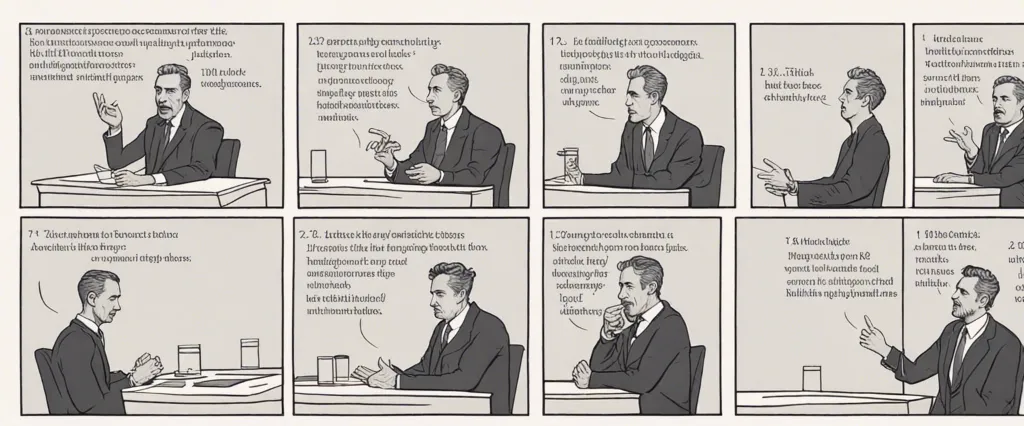
In an era defined by rapid technological advancements and an ever-evolving societal landscape, the pursuit of personal fulfillment and happiness becomes increasingly elusive. As individuals strive to navigate the complexities of modern life, two thought-provoking books emerge, shedding light on the path to contentment: “12 Rules for Life” by Jordan Peterson and “The Happiness Curve” by Jonathan Rauch.
Within these literary works, Peterson and Rauch delve deeply into the human experience, dissecting the intricacies of human nature and the factors that shape our well-being. While both authors offer unique perspectives, their fundamental aims align—understanding the challenges we face and uncovering the keys to leading purposeful lives.
In “12 Rules for Life,” psychologist and professor Jordan Peterson presents readers with a compelling guide to tackling the chaos within ourselves and the world around us. Drawing on his experiences as a clinical practitioner, Peterson offers a profound analysis of human behavior, emphasizing the need for individuals to take responsibility for their lives, confront their insecurities, and find meaning amidst the turmoil. With each of his twelve rules, Peterson unearths profound insights, showcasing the power of personal discipline, order, and self-reflection in achieving a balanced and fulfilling existence.
On the other hand, Jonathan Rauch, a renowned journalist and social commentator, explores a different facet of the human experience in “The Happiness Curve.” Relying on extensive research from sociology, psychology, and neuroscience, Rauch provides a captivating exploration of the often-overlooked phenomenon known as the happiness curve—an inevitable dip in well-being that occurs in midlife and rebounds with age. While society tends to emphasize the pursuit of happiness and achievement during youth, Rauch reveals the valuable lessons we can learn from embracing life’s challenges and recalibrating our expectations as we age, ultimately leading to a deeper sense of contentment.
This comparative study aims to investigate the contrasting perspectives presented by Peterson and Rauch. By critically examining their ideas on personal growth, societal influences, and the quest for happiness, we aim to gain a comprehensive understanding of the diverse paths these authors propose. As we delve into the depths of their narratives and explore the connections between their respective philosophies, we hope to uncover valuable insights that can guide individuals towards a more fulfilling and enriched existence in an ever-changing world. Through this comparative analysis, we aim to shed light on the complexities of human nature and illuminate the universal truths that transcend the boundaries of these two thought-provoking works.
Brief Summary of Two Books
12 Rules for Life by Jordan Peterson
12 Rules for Life: An Antidote to Chaos” is a self-help book written by Canadian psychologist Jordan Peterson. In this book, Peterson presents a series of twelve rules that he believes can help individuals find meaning, purpose, and order in their lives amidst the chaos and challenges of the modern world.
Each chapter focuses on a different rule, with Peterson weaving together a combination of psychological insights, philosophical ideas, religious mythology, and personal anecdotes to support his arguments. The rules address various aspects of life, from personal responsibility and the pursuit of truth to the fostering of meaningful connections and the significance of personal integrity.
Some of the key rules highlighted in the book include standing up straight with your shoulders back, taking responsibility for your life, and comparing yourself to who you were yesterday rather than to others. Peterson argues that these rules can help individuals develop resilience, navigate adversity, and cultivate well-being in their personal and professional lives.
Throughout the book, Peterson emphasizes the importance of confronting and grappling with the inherent suffering and chaos in life, while also encouraging readers to find meaning and purpose through meaningful relationships, personal growth, and the pursuit of truth. Ultimately, the book presents a set of guidelines aimed at helping individuals lead more meaningful, responsible, and fulfilling lives amidst the complexities of the modern world.
The Happiness Curve by Jonathan Rauch
“The Happiness Curve” by Jonathan Rauch explores the natural pattern of happiness that most people experience throughout their lives. The book reveals that contrary to popular belief, happiness tends to follow a U-shaped curve, with the highest levels in youth, a dip in middle age, and an upward trajectory in later life. Rauch delves into scientific research and interviews with experts to explain why this pattern occurs and how individuals can navigate the challenges of midlife to find renewed happiness and purpose later on. He suggests strategies for embracing the natural ebb and flow of emotions, fostering relationships, and finding fulfillment in work and personal life. Ultimately, “The Happiness Curve” offers a hopeful message, providing insights and practical advice for individuals seeking to achieve greater happiness and fulfillment at any stage of life.
Comparison between Two Books

Similarities in Know Yourself
Both “12 Rules for Life” by Jordan Peterson and “The Happiness Curve” by Jonathan Rauch emphasize the importance of self-awareness and understanding oneself for personal growth and fulfillment. Here are some similarities between the two books’ perspectives on knowing oneself:
1. Self-reflection: Both authors emphasize the need for individuals to engage in deep self-reflection to gain insights into their values, desires, and aspirations. They suggest that understanding one’s own motivations and thought patterns is crucial for making informed decisions and living a meaningful life.
2. Identifying strengths and weaknesses: Peterson and Rauch stress the significance of identifying both one’s strengths and weaknesses in order to capitalize on personal strengths and work towards personal improvement. Both books highlight the importance of recognizing limitations and areas for growth while also leveraging existing talents and abilities.
3. Embracing authenticity: Both authors advocate for authenticity and the importance of staying true to oneself. They emphasize that living a life aligned with one’s core values and beliefs leads to greater happiness and fulfillment. To achieve this, individuals must explore their own desires, confront their fears, and have the courage to be honest with themselves.
4. Emotional intelligence: Peterson and Rauch emphasize the importance of emotional intelligence and self-awareness in navigating relationships and dealing with challenges. They encourage readers to understand their own emotions, triggers, and behaviors to develop healthier and more fulfilling relationships with others.
5. Challenge limiting beliefs: Both books urge readers to examine their core beliefs and challenge any limiting or self-sabotaging thought patterns. By understanding the influence of past experiences and questioning negative self-perceptions, individuals can proactively work towards personal growth and positive change.
In summary, both “12 Rules for Life” and “The Happiness Curve” highlight the significance of self-awareness, self-reflection, authenticity, emotional intelligence, and challenging limiting beliefs as important aspects of knowing oneself and cultivating a fulfilled life.
Divergences in Know Yourself
When comparing the books “12 Rules for Life” by Jordan Peterson and “The Happiness Curve” by Jonathan Rauch, we can observe a significant divergence in their approaches towards the concept of “Know Yourself.”
In “12 Rules for Life,” Jordan Peterson emphasizes the importance of self-reflection and introspection. He argues that individuals should take responsibility for their lives by exploring their own motives, desires, and fears. Peterson believes that true self-knowledge requires individuals to confront their own weaknesses and faults. By facing these truths, individuals can embark on a journey of personal growth, self-improvement, and ultimately find meaning in their lives.
On the other hand, in “The Happiness Curve,” Jonathan Rauch approaches the idea of “Know Yourself” from a different perspective. Rauch explores the concept of a happiness curve, which suggests that individuals tend to experience a dip in happiness during middle age, only to find it increasing again as they grow older. He argues that this midlife dip occurs due to various societal and biological factors, and that self-awareness plays a crucial role in navigating this phase. Rauch emphasizes the importance of understanding the underlying causes of one’s discontent and using this knowledge to make intentional choices that can lead to a greater sense of fulfillment.
The divergence between the two books lies in the emphasis and application of self-reflection. Peterson’s approach urges individuals to delve deep into their psyche, addressing their flaws and striving for personal improvement. In contrast, Rauch’s focus lies more on understanding the external factors that influence one’s happiness and recognizing them as a means for self-awareness and informed decision-making.
Additionally, while Peterson’s “Know Yourself” is a more individualistic and self-centric concept, Rauch’s approach highlights the significance of understanding oneself in relation to the external environment and societal expectations.
In summary, “12 Rules for Life” emphasizes confronting personal weaknesses and striving for self-improvement, while “The Happiness Curve” stresses the importance of self-awareness within the context of external factors influencing happiness. These divergent approaches towards “Know Yourself” showcase the different philosophies and perspectives offered by these two thought-provoking books.

Conclusion
Both “12 Rules for Life” by Jordan Peterson and “The Happiness Curve” by Jonathan Rauch are well-regarded books that offer valuable insights. The book that is more worthy of reading would depend on individual preferences and interests.
If you are interested in personal development, psychology, and practical advice for navigating life’s challenges, “12 Rules for Life” by Jordan Peterson may be a suitable choice. It provides a set of rules to follow for individual betterment and includes perspectives on meaning, responsibility, and fulfillment.
On the other hand, if you are more interested in understanding the psychological and sociological aspects of happiness and its changes over a lifetime, “The Happiness Curve” by Jonathan Rauch might be a better fit. This book delves into the impact of midlife crises, explores the science behind happiness, and offers insights on finding contentment as we age.
Ultimately, both books have their own merits, and it would be worth considering your personal interests to determine which book resonates more with you.



